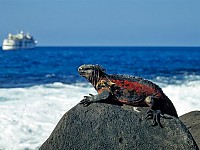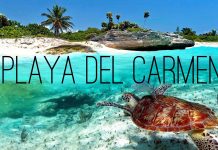This post may contain affiliate links. We may earn money or products from the highlighted keywords or companies or banners mentioned in this post.

The Galapagos Islands is a beautiful archipelago in the Pacific Ocean under the administration of Ecuador. It is a real treasure trove of wildlife and natural beauty and as such the Galapagos tourism is booming. However, the question is, do these visitors benefit to the biodiversity of the volcanic archipelago?
No wonder Charles Darwin visited the archipelago in 1835. The islands are incredibly rich in terms of flora and fauna. What is interesting about the local animals is their fearlessness. Tourists have an opportunity to get very close to the impressive fauna which the islands provide.
Frigatebirds, huge iguanas, sea lions all feel somewhat shockingly indifferent to the presence of people around them.
However, thanks to Galapagos tourism, the animals sometimes face people that behave in a harmful way. Over the years, many visitors have acted more as a threat rather than a protector of the wilderness. For example, regarding giant tortoises, in the 16th century there were 250,000 of them. This number fell to around 3,000 in the 1970s, and now as a result of conservation and restoration efforts there are about 20,000 of them on the Galapagos.
In 2015 about 224,000 tourists visited the islands and more come each year. Scientists are concerned that humans could change animals’ natural behavior. For example, the experts warn that penguins may become stressed by the presence of people, which could prevent them from parenting properly.
The bigger threat to the islands however is the potential introduction of foreign species to the islands’ isolated ecosystems. The smallest particles can be a threat to species that could lead to animal extinctions. Or even parasites and germs, as confirmed by Axel Krumsiek, project manager for marine ecosystems at WWF Germany.
“A species of parasitic fly that's exotic to the islands was unintentionally introduced. Its larvae suck the blood of fledgling finches – resulting in malformations and higher mortality,” Krumsiek explained.
As a result, Ecuador has introduced regulatory measures for Galapagos tourism and have expanded the Galapagos National Park to 97% of the islands and 99% of the surrounding waters.
The government also limits the size and routes of cruise ships. Tourists can only visit the islands with certified guides and can only walk on designated paths. Bringing food and touching the fauna is strictly forbidden.
As if it was not enough, climate change is also an issue which worries the scientists in relation to the Galapagos Islands. Natural events such as El Nino have caused the decline of sardine population leading to a disruption of the food chain.
Among others, penguins could also be at risk as a result of El Nino and the climate change. For example, in 1997 during El Nino the penguin mortality rates increased up to 77%.










